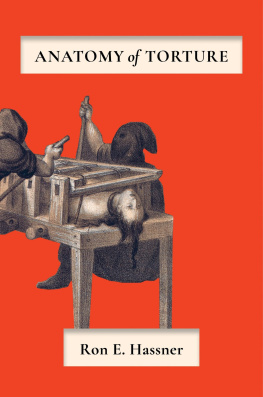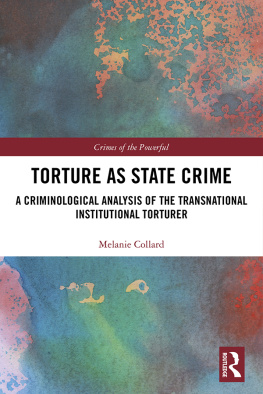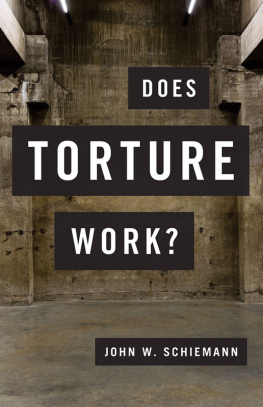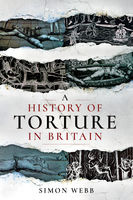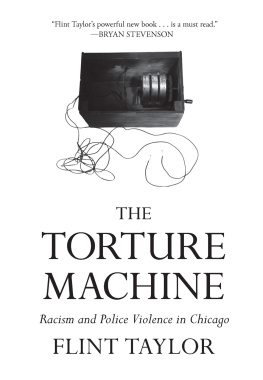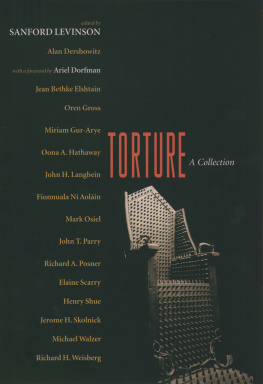Anatomy of Torture
Ron E. Hassner
Cornell University Press Ithaca and London
In memory of Carolyn Paxton (19482020)
who loved truth, justice, and history,
and cherished human worth and dignity
Contents
1
How Little We Know about Torture
Does torture work? My answer will frustrate some readers and infuriate others. Those who believe that torture doesnt work will read that torture has, at times, forced victims to divulge crucial and truthful information that they would not otherwise have revealed. On the other hand, those readers who regard torture to be a quick and effective, if cruel, tool for addressing ticking bomb threats will learn that torture is slow and tends to provide fragmentary information even under optimal conditions. It also exacts a tremendous social, political, and moral cost. Bluntly put, torture works but not the way you think it does.
It is impossible to assess the nature of modern torture. We know too little about contemporary cases, in the United States or elsewhere. Most of the information on recent US torture is classified and is likely to remain inaccessible for decades to come. Evidence from twentieth-century cases is equally sparse. Governments that have engaged in torture have not released comprehensive data that would permit a thorough analysis. Witness accounts are no less problematic. Victims and perpetrators alike are loath to share their experiences. Social science research on confrontational interrogation methods relies on analyses of police interrogations or on laboratory experiments, neither of which involve torture.
There exists, however, an underutilized historical source that can shed significant light on the nature of torture. That source is the archives of the Spanish Inquisition. This book is the first to wield extensive data from the Inquisition in order to conduct a dispassionate empirical analysis of torture, its causes, characteristics, and effects. I analyze scores of manuscripts, drawn from key periods in the history of the Spanish Inquisition, to provide an anatomy of torture. To analyze these findings, I bring together two research programs that have not been in conversation with one another: the historiography of the Spanish Inquisition and the study of contemporary interrogational torture. I analyze the intersection of these two literatures by means of a third field of inquiry, the scholarship on intelligence analysis, to explore how the Inquisition assessed information extracted by coercive and noncoercive means and to explain why it adopted the torture practices that it came to adopt.
This book does not purport to provide the anatomy of torture. Five-hundred-year-old evidence can only teach us so much about current torture practices. This is an anatomy of torture. It is a study of how torture has been employed in the past, in a specific period and under particular circumstances. Those circumstances are extreme: the Inquisitions target population was confined within the realms of an authoritarian state in which the Inquisition wielded absolute power and could draw on near-unlimited resources. The most important of these resources was time. The Inquisition suffered none of the pressures of a combat setting or an antiterrorism campaign. It could afford to spend decades and centuries perfecting its methods, and it could afford to dedicate years to gathering evidence against its prisoners. Thus the specific anatomy of torture presented here functions as an a fortiori argument. It showcases the strengths and weaknesses of torture under the most permissive conditions, which are unlikely to be met during future interrogation efforts in the United States or other democracies.
How best to define torture has become a matter of some contention in the context of the US counterterrorism effort post-9/11. The United Nations Convention against Torture defines torture broadly to include any act by which severe pain and suffering, whether physical or mental, is intentionally inflicted on a person for such purposes as obtaining from him or a third person information or a confession, punishing him for an act he or a third person has committed or is suspected of having committed, or intimidating or coercing him or a third party. In contrast, US advocates of enhanced interrogation have conceived of torture more narrowly to include only physical pain that is equivalent in intensity to serious physical injury, such as organ failure or death. They have argued that US coercive interrogation practices fall short of constituting torture.
No such ambiguity clouds the Inquisitions definition of torture. As I elucidate in the next chapter, inquisitorial handbooks defined torture very clearly. It consisted of only three forms of physical coercion, applied only in the torture chamber, under strictly delimited circumstances. The Inquisition did not regard harsh confinement prior to interrogation, or the threat of torture, to be torture, nor did it regard painful sentences executed after the end of a trial, such as lashes or hard labor, to be part of that torture.
Institutions have employed torture to punish, hurt, and terrorize. My focus in this book is exclusively on interrogational torture, torture designed to extract information. Interrogational torture is analytically distinct from confessional torture, torture designed to elicit particular statements. In reality, these categories overlap, and they overlap with other forms of torture, such as torture designed to intimidate, or control a population. Often, torturers will purport to torture for one purpose while introducing other goals, intentionally or accidentally.
I divide interrogational torture into two types: exploratory torture and corroborative torture. Exploratory torture is interrogational torture that occurs early in an investigation in order to reveal novel information. As I show, this type of interrogational torture rarely yielded information that the Inquisition found significant or reliable. In the absence of parallel sources of information, detainees subjected to exploratory torture were able to provide false information, hide true information, or pretend not to know much. Indeed, given how sparse information can be at the outset of an investigation, the Inquisition often subjected detainees to exploratory torture even though they had no relevant information to share. Exploratory torture fails because it risks interrogating the wrong individuals and because it fails to uncover the right information. A second type of interrogational torture, corroborative torture, occurs toward the end of an investigation. It is used to confirm or reject prior information, not to generate new discoveries. At times, this type of interrogational torture provided the Inquisition with truthful, and useful, information. Nonetheless, the Inquisition treated its results with suspicion, as one questionable source among many in its investigations.
The next chapter will demonstrate that the primary goal of inquisitorial torture was interrogational, and not confessional as is often falsely believed. The Inquisition was not interested in unfalsifiable claims about belief, and it did not demand, let alone believe, confessions of faith. The confessions that the Inquisition sought were falsifiable statements of fact about heretical practices, not heretical ideas or sentiments. The Inquisition corroborated these testimonies by contrasting them with parallel sources of evidence, as any intelligence-gathering organization would. In that sense, its stated goals were not much different than the purported goals of contemporary intelligence agencies. And since the stated goal of inquisitorial torture was interrogatory, that is also the standard against which I evaluate its results. Did its suspects reveal accurate information that the Inquisition considered useful, as a result of torture, that they would not have revealed in the absence of torture?

